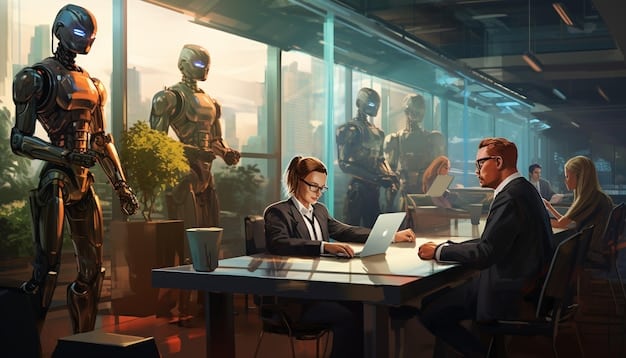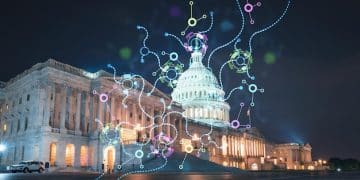The Future of Work: How Will AI and Automation Transform US Jobs?

Advertisements
The advent of artificial intelligence and automation stands poised to fundamentally reshape the labor landscape in the United States, driving both job displacement and the creation of entirely new roles, demanding a significant societal adaptation to evolving skill sets.
Advertisements
As technological advancements accelerate, particularly in the realms of artificial intelligence (AI) and automation, a pressing question emerges: The Future of Work: How Will AI and Automation Transform US Jobs? This transformation isn’t an abstract concept; it’s a dynamic force already reshaping industries and careers across the United States.
The Dawn of Automation: A Historical Perspective and Current Trajectories
The concept of machines performing tasks once reserved for humans is not new. From the agricultural revolution’s mechanization to the industrial era’s assembly lines, technology has consistently redefined labor. What sets the current wave apart is the unprecedented speed and cognitive capabilities of AI and advanced automation.
Advertisements
Historically, technological shifts often displaced manual labor while creating new opportunities in supervising or maintaining machines. Today’s AI, however, can mimic—and in some cases, exceed—human cognitive abilities, raising questions about jobs requiring intellectual and analytical skills. Understanding this trajectory is crucial to predicting future impacts.
Evolution of Automation in the Workplace
Early automation focused on repetitive, high-volume tasks. Think of industrial robots on manufacturing floors. These machines excelled at precision and endurance, alleviating humans from strenuous or dangerous work. The economic benefits were clear: increased production, reduced costs, and often, improved safety.
The current phase, often referred to as “smart automation” or “intelligent automation,” incorporates AI, machine learning, and sophisticated sensors. This allows for adaptability, learning from data, and performing tasks that require decision-making beyond rule-based programming. It’s a leap from simply executing commands to understanding contexts and optimizing processes.
- Manufacturing Evolution: From rigid, repetitive robots to adaptable collaborative robots (cobots) working alongside humans.
- Service Sector Transformation: Automated kiosks, chatbots for customer service, and AI-driven predictive analytics reshaping retail and finance.
- Data-driven Decision Making: AI systems analyzing vast datasets to inform strategic business decisions, previously the exclusive domain of human analysts.
The pace of this technological integration is accelerating, driven by decreasing costs of hardware and increasingly sophisticated algorithms. Companies are adopting AI not just for efficiency, but for competitive advantage, leading to broad deployment across various sectors.
The historical pattern of job evolution, where new roles emerged as old ones faded, provides a framework, but the scale and type of disruption posed by AI demand unique consideration. The current trajectory suggests a future where human and machine collaboration becomes the norm, rather than an exception.
Sectors Under the AI Microscope: Where Disruption is Most Likely
Not all sectors will be affected equally by AI and automation. Some industries, characterized by routine, predictable tasks and high volumes of data, are particularly susceptible to rapid transformation. Identifying these areas helps us anticipate challenges and prepare workforces.
Examining specific sectors reveals a nuanced picture of job displacement, augmentation, and creation. While some roles might diminish, others will evolve, requiring new skills and human oversight of automated systems. This section delves into the most impacted industries.

High-Risk Sectors and Their Vulnerabilities
The sectors most likely to experience significant disruption are those with a high proportion of transactional or rule-based tasks. These include administrative support, manufacturing, transportation, and certain aspects of finance and customer service.
Manufacturing has long embraced automation as discussed, but AI is now enhancing precision, quality control, and supply chain management. In transportation, autonomous vehicles threaten long-haul trucking and taxi services. Financial services see AI handling fraud detection, algorithmic trading, and personalized financial advice.
- Administrative and Clerical Roles: Data entry, scheduling, and routine correspondence can be automated, requiring fewer human hands.
- Manufacturing and Production: Advanced robotics and AI-powered quality control reduce the need for manual assembly and inspection.
- Transportation: Autonomous vehicles are poised to revolutionize logistics, ride-sharing, and freight movement.
- Customer Service: Chatbots and AI-driven support systems are handling an increasing volume of customer inquiries, especially in repetitive cases.
While some jobs within these sectors may be displaced, it is more accurate to envision a transformation rather than complete eradication. For example, a customer service representative might transition from answering basic queries to resolving complex, emotionally charged issues that AI cannot yet handle.
The Nuance of Automation: Augmentation vs. Displacement
The narrative often focuses solely on job displacement, but augmentation—where AI tools enhance human capabilities—is equally significant. In healthcare, AI aids in diagnostics, allowing doctors to focus on treatment and patient care. In law, AI accelerates document review, freeing lawyers for strategic thinking.
Many jobs will not disappear but will fundamentally change. The human role will shift towards tasks requiring empathy, creativity, critical thinking, and complex problem-solving—areas where AI currently lags. This implies a need for upskilling and reskilling across the workforce.
The real challenge lies in managing this transition, ensuring that individuals whose jobs are impacted have pathways to new opportunities. This requires proactive policy, educational reforms, and a societal commitment to lifelong learning.
New Opportunities and Emerging Roles in the AI Economy
While the focus often remains on job displacement, AI and automation are simultaneously catalysts for significant job creation. The development, deployment, maintenance, and ethical oversight of these technologies demand specialized skills and entirely new professional categories.
The AI economy fosters an ecosystem of innovation, leading to roles that didn’t exist a decade ago. Understanding these emerging opportunities is critical for individuals and institutions charting future career paths. This section explores these burgeoning roles and their prerequisites.
Roles in AI Development and Maintenance
The foundational layer of the AI economy involves those who build and refine the technology itself. This includes roles in data science, machine learning engineering, AI research, and robotics. These positions require deep technical expertise, often in computer science, statistics, or related STEM fields.
Beyond creation, there’s a growing need for professionals to maintain, troubleshoot, and optimize AI systems. AI ethics specialists, for instance, are becoming crucial as algorithms influence more aspects of daily life, ensuring fairness and accountability.
- AI Engineers/Machine Learning Scientists: Developing and implementing AI models and algorithms.
- Data Scientists: Analyzing complex datasets to extract insights and train AI systems.
- Robotics Engineers: Designing, building, and programming autonomous machines.
- Ethical AI Researchers: Ensuring AI systems are fair, transparent, and aligned with societal values.
These roles are typically high-skilled and command competitive salaries, reflecting the specialized knowledge required. The demand for these professionals is projected to grow significantly as AI becomes more pervasive across industries.
Human-AI Collaboration and Augmentation Roles
Perhaps the most widespread impact will be the creation of roles that focus on human-AI collaboration. These jobs involve leveraging AI tools to enhance productivity, creativity, and decision-making. Examples include AI trainers, who refined machine learning models through supervised learning, or prompt engineers, who optimize AI outputs.
In many fields, AI will act as a powerful co-pilot. For instance, in design, an architect might use AI to generate multiple preliminary designs, then human creativity filters and refines the best options. This collaboration elevates human potential, allowing focus on higher-level tasks.
The ability to work effectively alongside AI, understanding its capabilities and limitations, will become a universal skill. This shift demands a focus on ‘soft skills’ such as critical thinking, adaptability, and problem-solving, which are inherently human.
The emerging landscape suggests a future where most jobs will integrate some form of AI, requiring proactive upskilling to harness these new tools effectively. This symbiosis will redefine productivity and innovation.
The Imperative of Reskilling and Upskilling for the Future Workforce
Given the transformative power of AI and automation, simply reacting to job changes will be insufficient. A proactive and continuous effort in reskilling and upskilling the workforce is not merely an option but an absolute necessity for economic resilience and individual prosperity.
This section explores the critical importance of these educational initiatives, highlighting the types of skills that will be most in demand and the various pathways individuals and institutions can pursue to prepare for the evolving job market.
Identifying Future-Proof Skills
While technical skills related to AI and data science are vital, the truly ‘future-proof’ skills are those that AI struggles to replicate. These include complex critical thinking, creativity, emotional intelligence, complex problem-solving, and cross-cultural communication.
Human-centric skills, such as empathy, negotiation, and ethical reasoning, will become increasingly valuable as routine tasks are automated. The ability to innovate and adapt to rapid technological change will also be paramount.
- Critical Thinking and Complex Problem Solving: Analyzing intricate issues and developing innovative solutions.
- Creativity and Innovation: Generating new ideas and approaches beyond algorithmic patterns.
- Emotional Intelligence and Empathy: Understanding and managing emotions in human interactions.
- Digital Literacy and AI Fluency: Basic understanding of how AI works and how to effectively use AI tools.
These skills bridge the gap between human capabilities and machine efficiencies, creating synergistic relationships. Education systems, from K-12 to higher education, must integrate these competencies into their curricula.
Pathways for Reskilling and Upskilling
The responsibility for reskilling and upskilling lies with multiple stakeholders: individuals, corporations, educational institutions, and government. For individuals, embracing lifelong learning through online courses, certifications, and vocational training will be crucial.
Corporations have a vested interest in upskilling their existing workforce to navigate technological shifts. This can involve in-house training programs, tuition reimbursement, or partnerships with educational providers. Government policies can incentivize such corporate initiatives and provide support for displaced workers.
- Online Learning Platforms: Coursera, edX, and others offer flexible access to specialized courses and certifications in AI, data science, and soft skills.
- Vocational Schools and Community Colleges: Providing practical, hands-on training for technical trades and emerging roles.
- Corporate Training Programs: Companies investing in their employees’ development to maintain a competitive edge.
The goal is to foster a culture of continuous learning, enabling a flexible workforce that can adapt to the rapid changes brought about by AI and automation. Investment in these pathways is an investment in economic stability and human potential.
Policy and Societal Implications: Navigating the Transition
The transformation of US jobs by AI and automation extends far beyond mere technological shifts; it presents profound policy and societal challenges. Governments, businesses, and communities must collectively address issues ranging from economic inequality to ethical governance of AI if they are to navigate this transition successfully.
This section delves into the critical policy considerations and broader societal implications, including the need for new social safety nets and a re-evaluation of workforce development strategies to ensure an equitable future.
Rethinking Social Safety Nets and Education Systems
As job structures change, existing social safety nets may prove inadequate. Discussions around universal basic income (UBI), although controversial, highlight a recognition that traditional employment models may not support everyone in an automated future. Unemployment benefits and retraining programs need significant upgrades to be effective.
Education systems require a fundamental overhaul. The emphasis must shift from rote learning to critical thinking, creativity, and adaptability. Lifelong learning must become the norm, supported by accessible and affordable educational opportunities across all age groups.
- Universal Basic Income (UBI): Exploring foundational income models to cushion economic disruption from widespread automation.
- Enhanced Retraining Programs: Government-funded initiatives providing accessible and relevant training for new economy jobs.
- Curriculum Reform: Emphasizing STEM, digital literacy, and human-centric skills in K-12 and higher education.
These policy adjustments are not just about protecting workers; they are about fostering innovation and maintaining social cohesion during a period of unprecedented change. Proactive policymaking can mitigate potential negative outcomes.
Ethical AI and Regulatory Frameworks
The proliferation of AI also raises significant ethical questions. Bias in algorithms, data privacy concerns, and the potential for autonomous systems to make critical decisions without human oversight demand careful consideration. Robust regulatory frameworks are essential to ensure AI development aligns with societal values.
Governments must work with tech companies, academics, and civil society to establish clear guidelines for AI development and deployment. This includes transparency in algorithmic decision-making, accountability for AI outcomes, and protecting individual rights.
The development of ethical AI frameworks is crucial to building public trust and avoiding potential harms. Without a thoughtful regulatory approach, the benefits of AI could be overshadowed by unintended negative consequences, creating new forms of inequality or societal instability.
Navigating the Unknown: Preparing for an Agile and Adaptable Future
The exact contours of “The Future of Work: How Will AI and Automation Transform US Jobs?” remain fluid, subject to technological breakthroughs, policy choices, and human ingenuity. However, one certainty stands clear: the future workforce must be inherently agile and supremely adaptable.
This final section synthesizes the preceding discussions, emphasizing the critical mindset and strategic approaches necessary for individuals, businesses, and governments to thrive—not just survive—in an era defined by continuous technological evolution.
Embracing Permanent Learning and Flexibility
For individuals, the concept of a fixed career path is rapidly becoming obsolete. The ability to learn, unlearn, and relearn will be the most valuable skill set. This means cultivating intellectual curiosity, seeking out continuous education, and being open to completely shifting professional directions multiple times over a career.
Flexibility will extend beyond skill sets to work arrangements. The gig economy, remote work, and project-based employment are likely to become more prevalent, requiring individuals to manage their careers with greater autonomy and entrepreneurship.
- Lifelong Learning Mindset: Viewing education as a continuous journey, not a fixed destination.
- Skill Stack Approach: Developing a diverse portfolio of interconnected skills rather than specializing in a single, narrow area.
- Entrepreneurial Spirit: Adapting to new opportunities and creating value in dynamic environments.
This shift demands a proactive stance from workers, viewing technological change not as a threat but as an ongoing challenge that offers opportunities for growth and innovation. The resilient worker will be the one who embraces continuous learning.
Strategic Adaptation for Businesses and Government
Businesses must move beyond optimizing for current efficiencies and instead plan for future adaptability. This involves investing in AI integration, but equally important, investing in their human capital through robust training and development programs. Companies that view AI as a tool for human augmentation, rather than pure replacement, will likely thrive.
Governments, similarly, must adopt long-term, agile strategies. This includes fostering innovation through supportive policies, investing in critical infrastructure (like universal broadband), and creating social safety nets that support transitions between roles, not just periods of unemployment. Regulatory frameworks must strike a balance between fostering innovation and protecting workers and citizens.
The collective effort to anticipate, adapt, and innovate will shape whether the transformative power of AI and automation leads to a future of shared prosperity or increased societal division. The journey ahead requires foresight, collaboration, and an unwavering commitment to human progress.
| Key Aspect | Brief Description |
|---|---|
| 🤖 Job Transformation | AI and automation will displace routine jobs but create new, complex roles requiring human-centric skills. |
| 📚 Skill Shift | Demand for creativity, critical thinking, emotional intelligence, and digital fluency will surge. |
| 🎓 Reskilling Imperative | Continuous learning, upskilling, and dedicated training programs are essential for workforce adaptation. |
| ⚖️ Policy & Ethics | Governments must adapt policies for social safety nets and establish ethical AI regulatory frameworks. |
Frequently Asked Questions About AI and the Future of Work
▼
No, AI is highly unlikely to eliminate all human jobs. While it will automate many routine tasks and displace certain roles, it will also create new jobs, augment existing ones, and shift the demand towards uniquely human skills like creativity, critical thinking, and emotional intelligence. The future points towards human-AI collaboration rather than total replacement.
▼
Sectors with a high proportion of repetitive, rule-based, or physically demanding tasks are most vulnerable. These include manufacturing, transportation (e.g., trucking), administrative support, and some areas of customer service and finance. However, even within these sectors, many roles will be augmented rather than fully displaced.
▼
AI will create numerous new roles, particularly in its development, maintenance, and ethical oversight. Examples include AI engineers, data scientists, robotics technicians, AI ethicists, prompt engineers, and human-AI collaboration specialists. Many existing jobs will also evolve to incorporate AI tools, requiring new digital literacy and AI fluency.
▼
Individuals can prepare by embracing lifelong learning, focusing on developing human-centric skills (e.g., critical thinking, creativity, emotional intelligence), and acquiring digital literacy. Pursuing certifications, online courses, and vocational training in emerging fields, or learning to effectively use AI tools in their current roles, will be crucial.
▼
Governments must reform educational systems, update social safety nets, and establish ethical AI regulations. Businesses need to invest in employee reskilling, foster a culture of innovation, and strategically integrate AI as an augmentation tool rather than solely for cost-cutting. Collaboration between these stakeholders is vital for a smooth transition.
Shaping a Symbiotic Future
The journey into “The Future of Work: How Will AI and Automation Transform US Jobs?” is not one of passive observation but active participation. The narrative of AI is not solely about displacement; it’s profoundly about augmentation, creation, and the redefinition of human value in an increasingly intelligent world. While the challenges of job transition, economic inequality, and ethical governance are substantial, so too are the opportunities for unprecedented productivity, innovation, and a shift towards more fulfilling human endeavors. The onus is now on us—as individuals, educators, businesses, and policymakers—to collaborate, innovate, and proactively shape a future where technology serves humanity, creating a symbiotic relationship that elevates both our capabilities and our collective well-being.





